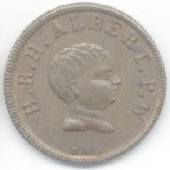
PREV ARTICLE
FULL ISSUE
PREV FULL ISSUE
FEATURED WEB PAGE: TEACHING COINSThis week's Featured Web Page is the Teaching Coins page from the U.K.'s Token Corresponding Society web site.

Albert, Prince of Wales - later Edward VII
These were issued to, or used by, schools from 1843 onwards to help children learn £.s.d. (pounds, shillings and pence) and to generally assist in learning to count money. From 1843 the coins were made in various metals - to match the currency - until the late 1800's. Then cardboard was used and these resembled the coins actually in use. This carried on until the late 1900's. Running alongside the cardboard from about the 1970's is a vast series of decimal coins in plastic, only some of which are "educational" with most being issued, by many manufacturers, for games and toys. [Plastic coins and tokens are also covered by a separate topic.]
TEACHING COINS IN METAL.
S. G. Onions produced a series of coins in 1843 for educational purposes - for teaching in schools and at home. It is an extremely rare series as most were lost by use and they are now over 160 years old. There are 10 main denominations from "1 SOVEREIGN IS 1 POUND" down to "4 FARTHINGS MAKE 1 PENNY". The portrait is always of the baby PRINCE ALBERT, PRINCE OF WALES (later King Edward VII) and each reverse has the correct number of dots for the denomination to help with counting. For example, "12 PENCE MAKE 1 SHILLING" has 12 dots. This is the coin most usually seen but is still rare. All the other denominations are very rare indeed. The coins range from only 11mm diameter to 17mm diameter. A variety of metals were used but the base metal is usually either copper or brass. The set was reputed to have been issued in a wire mesh bag but none seem to be known today.
www.tokensociety.org.uk/topics/teaching.shtmlWayne Homren, Editor The Numismatic Bibliomania Society is a non-profit organization promoting numismatic literature. See our web site at coinbooks.org. To submit items for publication in The E-Sylum, write to the Editor at this address: whomren@gmail.com To subscribe go to: https://my.binhost.com/lists/listinfo/esylum All Rights Reserved. NBS Home Page Contact the NBS webmaster 
|